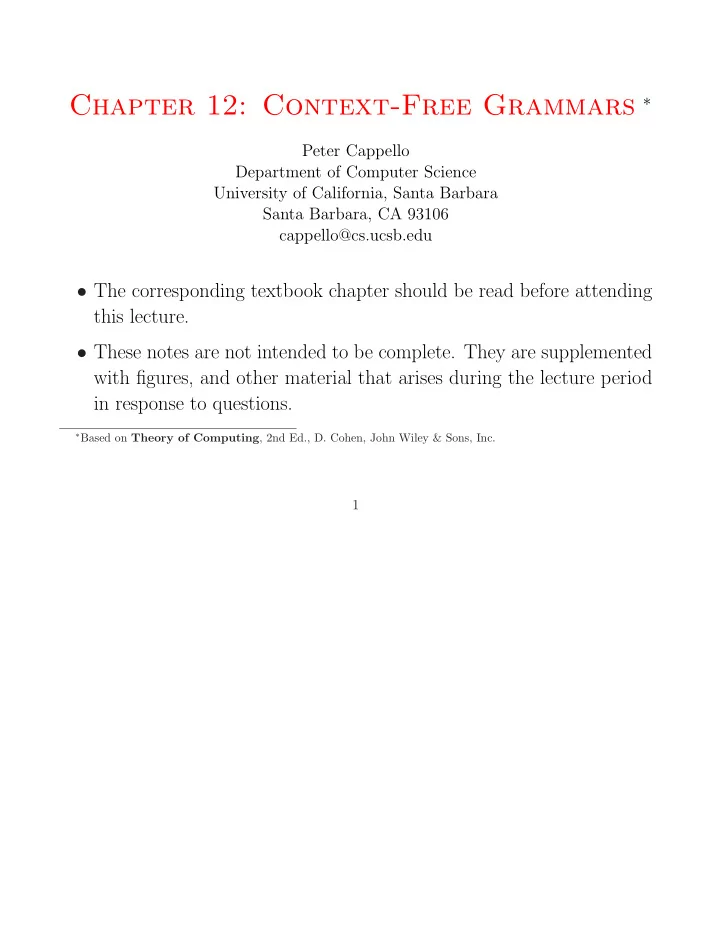

Chapter 12: Context-Free Grammars ∗ Peter Cappello Department of Computer Science University of California, Santa Barbara Santa Barbara, CA 93106 cappello@cs.ucsb.edu • The corresponding textbook chapter should be read before attending this lecture. • These notes are not intended to be complete. They are supplemented with figures, and other material that arises during the lecture period in response to questions. ∗ Based on Theory of Computing , 2nd Ed., D. Cohen, John Wiley & Sons, Inc. 1
Symbolism for Generative Grammars • The book chapter gives a good explanation of the background and reason for studying this material. • A generative grammar is a grammar with which one can generate all the words (sentences) in a language. 2
Definition A context-free grammar (CFG) is a collection of 3 things: • An alphabet Σ of letters called terminals . • A set of symbols called nonterminals , 1 of which is the symbol S, the “start” symbol. • A finite set of productions of the form Nonterminal → ( terminals + nonterminals ) ∗ At least 1 production has S as its left side. By convention, we use: • lower case letters and special symbols for terminals • upper case letters for nonterminals. 3
Definition The language generated by a CFG is the set of all strings of terminals produced from S using productions as substitutions. A language generated by a CFG is a context-free language (CFL). 4
Example Production 1 S → aS Production 2 S → Λ Applying production 1 two times, followed by production 2, yields: S ⇒ aS ⇒ aaS ⇒ aa Λ = aa • The language generated by this CFG is a ∗ . • → means “can be replaced by”. • ⇒ (used in a derivation) means “can develop into”. • A derivation’s right hand side (RHS) is a working string when it contains nonterminals. 5
Example Define a CFG that accepts ( a + b ) ∗ . S → aS S → bS S → Λ 6
Example Define a CFG that accepts ( a + b ) ∗ aa ( a + b ) ∗ . S → XaaX X → aX X → bX X → Λ Give a derivation of ababaaaba . 7
Example Define a CFG that accepts { a n b n } . S → aSb S → Λ Equivalently: S → aSb | Λ • Give a derivation of aaabbb . • Define a CFG that accepts palindromes over { a, b } . (It should include strings such as aba .) 8
Trees Given the CFG S → AA A → AAA | bA | Ab | a • Derive the word bbaaaab : S ⇒ AA ⇒ bAA ⇒ bbAA ⇒ bbaA ⇒ bbaAAA ⇒ bbaaAA ⇒ bbaaaA ⇒ bbaaaAb ⇒ bbaaaab • Draw the tree corresponding to this derivation. • Such a tree is called a syntax tree or parse tree. 9
Lukasiewicz Notation • Consider the CFG: S → + | ∗ | n + → + + | + ∗| + n | ∗ + | ∗ ∗| ∗ n | n + | n ∗ | n n ∗ → + + | + ∗| + n | ∗ + | ∗ ∗| ∗ n | n + | n ∗ | n n n → 1 | 2 | 3 | 4 | 5 | 6 | 7 | 8 | 9 • One possible derivation is S ⇒ + ⇒ 3 ∗ ⇒ 3 4 5. • Write the parse tree for this is on the board. • From the parse tree construct the prefix notation by walking around the tree, writing down the symbols in the order in which they are first visited (excluding S ): + 3 ∗ 4 5. 10
• Think of these items as having been pushed on a stack in the order of visitation. • To evaluate the expression, when the top 2 items are numbers: 1. pop the top 3 items 2. evaluate that expression (e.g., + 35 evaluates to 8) 3. push the resulting value on the stack Continue until the stack contains only 1 number. • Do this for our string of + 3 ∗ 4 5. • Do this for the following tree (((1 + 2) ∗ (3 + 4)) + 5) ∗ 6. (Its value should be 156.) 11
Ambiguity Definition: A CFG G is ambiguous if there exists a w ∈ L ( G ) with 2 derivations that correspond to different parse trees. If a CFG is not ambiguous it is unambiguous . Example Let CFG G be S → aS | Sa | a , the regular language aa ∗ . The word aa has 2 derivations: • S ⇒ Sa ⇒ aa • S ⇒ aS ⇒ aa distinct with a distinct parse tree. However a + can be defined by S → aS | a , which is not ambiguous. 12
The Total Language Tree Definition: For a given CFG, define a tree: • Its root is S • For each nonterminal node in the tree, For each nonterminal, N at that node, construct a child node in the tree for each production with N as the LHS. Example Let CFG G be: S → aa | bX | aXX X → ab | b • What is the total language tree for this CFG? • What is the total language tree for S → Λ | aSb ? 13
Recommend
More recommend